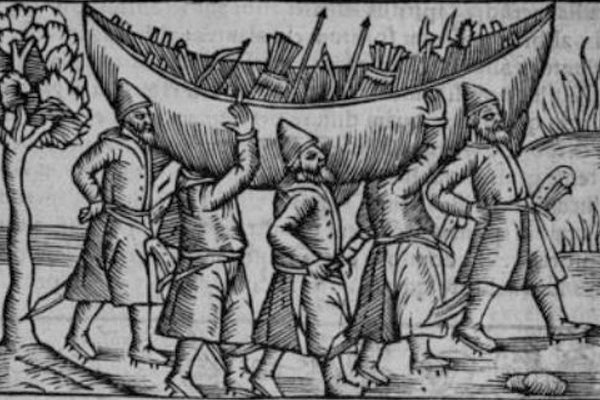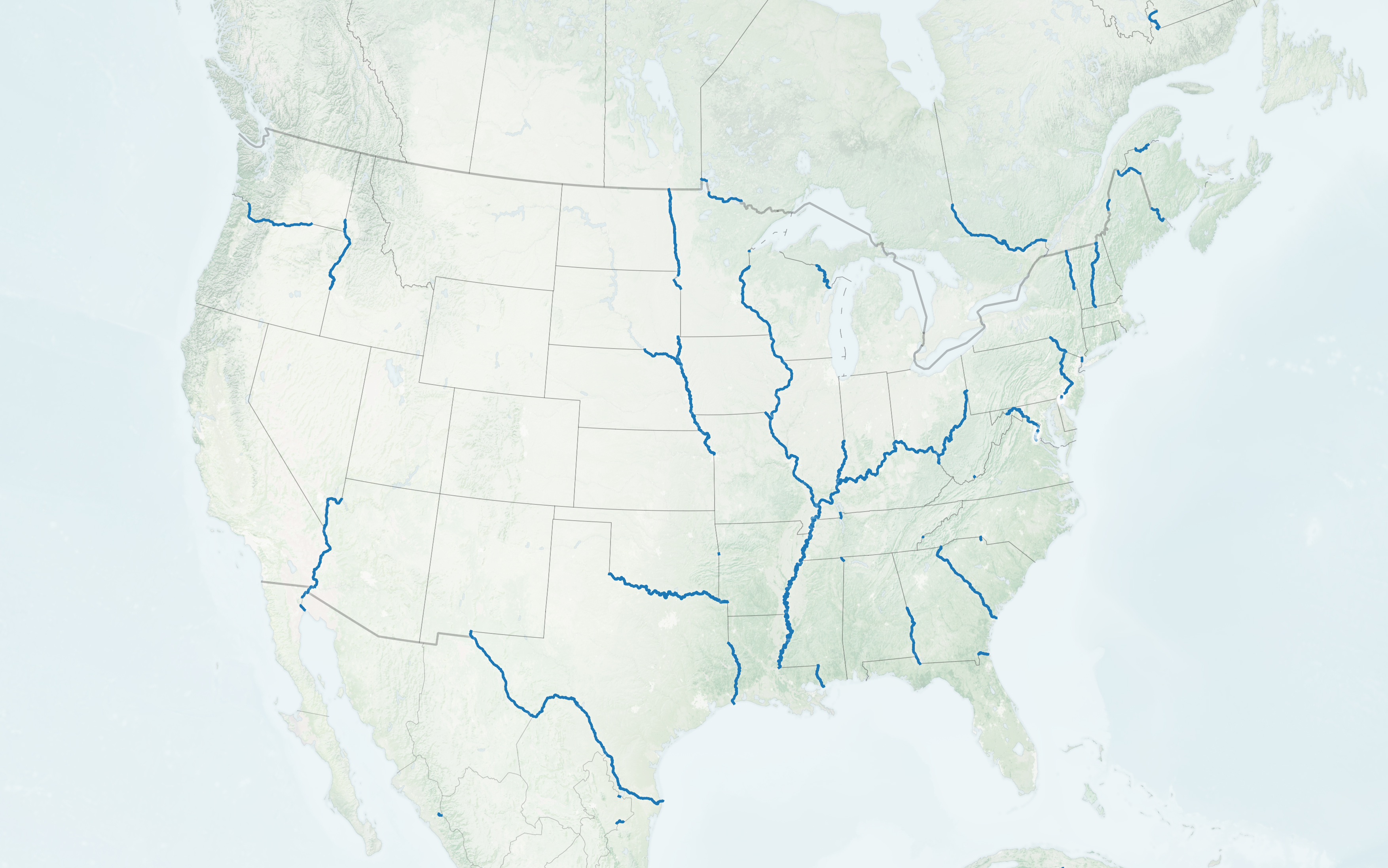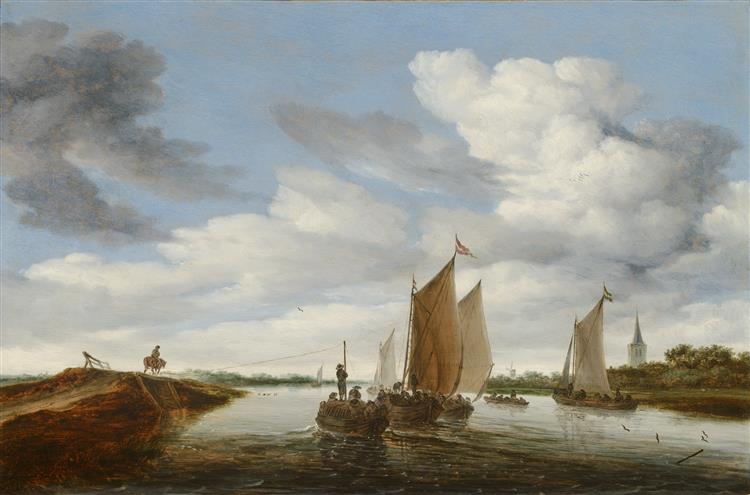Rivers are perhaps the most important part of pre-modern world building. That’s why it’s unfortunate rivers are commonly misunderstood and underutilized in D&D. Large rivers are the foundation of civilization and act as the primary means of travel for people, goods, and militaries. Because of their ingrained importance to society, we should expand on some basic river knowledge so you can do it right in your world building.
River Courses and Landforms
As noted in the previous segment, World Building Rivers & Watersheds, they start in the mountains and most often end in the ocean. We can divide the course of surface water from its terminus to its headwaters (furthest point from terminus) into three separate and distinct courses: high, middle, and low.
River High Course
The high course of a river starts at its headwaters at high elevations such as mountains, hills, and highlands. Water arrives at the high course by precipitation, snowmelt, and springs where the water table bubbles up to the surface. The waterways that form in the high course are shallow, narrow, and fast due to the drop in elevation over a short distance. Over time these waterways erode the land and create steep, v-shaped valleys. These waterways are the straightest of all the courses and, as a result, produce very little lateral erosion in the way of riverbanks.
The high course of a river comes to an end at the Fall Line. The fall line is often around the foothills. It’s a line of demarcation between the high and middle river courses where waterways “plunge” dramatically in elevation, resulting in rapids and waterfalls. Over time rivers can vertically erode the rock beneath them to create gorges and canyons. Gorges and canyons are waterways flanked by tall vertical cliffs. You can differentiate the two by their top/ridge. A gorge has a vertical ridge to its base, while a canyon is wider at its ridge than its base.
River Middle Course
A river’s fall line marks the change in the river’s course from the high course to the middle course. As well, it is often the waterway’s head of navigation point. The head of navigation is the furthest upriver boats can travel. Beyond this point, the waterway is too shallow or too steep an incline for boats to travel.
In the middle course, U-shaped valleys replace the V-shaped valleys. These wider valleys provide flatter ground, allowing the river to widen, slow down, and begin meandering (curving left and right). The middle course of a river often features the confluence (combining) of multiple tributaries (feeder streams), and the waterway is also deeper than the high course.

Shallow draft boats are often able to navigate the middle course of a river. An example of this would be some of the Viking ships, which could navigate significantly farther inland than most European kingdoms expected. Viking raiders were able to move inland quickly and raid locations far from the coast. Additionally, their ships were light, making them easy to portage (carry overland) to other rivers and made them very difficult to track and pin down.
A common feature of middle and lower course, meandering river courses are oxbows and oxbow lakes. An oxbow is when a river meander bends to almost make a complete circle before continuing. Over time, erosion will complete the circle, straighten the river’s course and leave behind an oxbow-shaped lake. Once the river reaches the flat coastal plains, it will leave behind the middle course and transition into the lower course.
River Low Course
The low course is best characterized by its position on flat lowlands and its wide, accompanying floodplain. The low course of a river is the culmination of many different river confluences throughout the river’s drainage basin and is easily the widest, deepest, and most meandering of the river courses. Rivers in the low course most often terminate in an ocean estuary (outflow), a confluence with another large river, or rarely in an inland sea/lake with no output.

The low course of a river is very important because of its level ground and floodplain. The low course river floodplain is home to fertile agricultural land and well-developed seasonal or permanent wetlands. The prevalence of good farming land and navigational ability makes the low course of a river an ideal location for city placement in your worldbuilding. Let’s investigate a little further the strategic importance of rivers.
Rivers & Strategic Positioning
Like mountains, rivers serve as great natural markers for political and administrative borders. Rivers often feature heavily in the shape of a political state either by helping to denote its border or because it serves as the heart of the state, its commerce, and administration.

Another major strategic consideration for rivers is their role in transportation inland and outland from the sea. Rivers are the superhighways and rail networks of the pre-industrial world. They play such an important role because they allow many people or goods to move over long distances quickly and efficiently. Inland goods can make their way downriver to the coast for export, and imports can make their way quickly to a region’s interior populations. This ability to move swiftly and efficiently is also of the utmost importance for military implementations. Being able to move an army quickly between locations faster and without the fatigue of marching means soldiers can get where they need to be fast and be fresh, ready to fight when they get there.
Transportation Breakpoints & Chokepoints
When considering where to place settlements in your world, rivers can help you out. When thinking about how goods and people use the rivers in your world, a few ideal places for settlements will appear. The first is a transportation breakpoint. A transportation breakpoint is any point in the travel of people or goods where the means of transport needs to be changed.
For example, most sea-faring vessels have too deep a draft to enter and travel up rivers. River estuary ports allow for people and goods to move from sea vessels to river vessels. Like other coastal ports, river estuary ports also serve as crucial resupply points for ships on sea voyages.
Other types of upriver ports will also develop along your waterways. They will often show up at the confluence of rivers, the waterway equivalent of a town growing at a crossroads. Some settlements develop at portage sites. Portaging is the act of moving goods, people, and vessels overland between two points of water traversal. Sometimes people need to portage around river shallows and rapids. Other times, they cross land to move to a different waterway, as we noted in the Viking example earlier. And eventually, goods will need to be offloaded at the Fall Line or Head of Navigation site, where boats can no longer continue. These high river settlements may have places where goods are moved from ships to beasts of burden to move inland or up through mountain passes.
Chokepoints are strategic, highly defensible points where the military can easily control access to and through an area. Coastal, estuary ports are both breakpoints and chokepoints. Another strong example is a river island. From this position, a military force can block and attack river vessels while enjoying a position that is very difficult to attack or siege. In the same way, a fortification or castle on the inside of a river meander can control river access while only needing to defend one side from opposing land forces.

But what happens when you have goods and people that want to move across the path of a river? River crossings too, are essential for allowing and controlling the transport of goods and people. An excellent example of the importance and use of a strong river crossing is The Twins from Game of Thrones.
River Crossings
River crossings come in three forms: fords, bridges, and ferries. Fords are shallow areas of a waterway that allow people and goods to cross a waterway by wading through the water. The simplest of the different types of river crossings, most fords occur naturally. But, they can be engineered and require less engineering than bridges. The downside of fords is that they can become impassable if the river’s water level becomes too high by heavy rain, flooding, or Spring snowmelt. Another problem with fords is they prevent the passage of watercraft. A problem that only persists in certain forms of bridges and ferries.
/cdn.vox-cdn.com/uploads/chorus_asset/file/3378444/Screen_Shot_2015-02-02_at_2.51.49_PM.0.png)
For an interesting fantasy use of fords and their importance in combat, take a look at the Battle of Sekala Crossing from the book Deadhouse Gates in the Malazan Book of the Fallen.
Types and Uses of Bridges
From fords we move on to bridges. Bridges serve the same purpose and surprisingly come with most of the same problems with fords. Of course, the biggest benefit to bridges is you don’t have to get your feet wet or worry about being swept away by the current while crossing the river. Bridges do have a propensity for failing, though. There’s a reason we don’t have a lot of bridges from antiquity that still exist. They often bridges were well, temporary, and were built alongside a ford in case the bridge failed. A bridge would usually fail because of an increase in water volume and velocity. The high waters of Spring or a flood would come and wash away the bridge. Then it would be rebuilt. Even Tarr Steps, an ancient clapper bridge made of large stones, is routinely damaged by the river’s current. For perspective, the tame river consistently washes two-ton stones downstream when the water rises.
Most bridges of the approximate historical period represented by Dungeons & Dragons would not be engineered for ships and boats to pass the waterway. And, why would they? As we already touched on, being at a transportation breakpoint is premium real estate for a settlement. That’s a state you can force by constructing a bridge that blocks passage for watercraft.
River crossing bridges come in two primary forms: single-span, and pile bridges. As the name says, the former spans across a river while the latter has piles (pillars) in the river to support the bridge. And these bridges come in a surprising variety of engineering.
D&D Bridge Types
- Stepping Stones
- Log Bridge (Felled tree over a river)
- Clapper Bridge (Lintel stones across stone piles)
- Bamboo/Timber Bridge Across Piles (Boardwalks are a type of timber bridge used traverse wetlands)
- Arch/Corbel Bridge (single span or piles) sometimes created to allow small watercraft to pass beneath
- Roving/Split Bridge (single span) designed specifically to accommodate animal-towed boats
Tow Boats
I do my best to incorporate river tow boats (narrowboats) into my D&D games. Tow boats offer an excellent alternative method of travel and the standard caravan protection quest. Tow boats are long and used to move goods up and down rivers and canals. What makes them stand out is that these boats are pulled by draught animals on a path along the bank instead of propelled by current, sail, oar, or push pole.

Tow boats offer some distinct advantages for moving cargo on a river/canal system. First, they offer a more reliable source of propulsion than sailing, and unlike relying on currents, a tow boat can move up or downstream. Using push poles on barges or other watercraft generally requires two crew members, and together they cannot equal the draught strength of a beast of burden. Oar propulsion has a similar problem because for every row of oars you add to the boat, it’s less cargo you can carry. Also, canals tend to be very narrow (in England, they’re 7 feet wide), making using oars nearly impossible.
Meanwhile, a single draught horse on a path guided by one crewmember or youth can tow a boat with upwards of 70 tons of cargo. Not bad for a means of propulsion fueled by the grass just off the towpath. All this to say, add some tow boats to your campaign. They’re great for a skirmish encounter because the PCs need to protect the boat, the goods on the deck, the crew, and the horse on the path. With the canal so narrow, thieves could quickly jump onto the boat, grab whatever they can carry, and flee. Or, they could take the horse and leave the boat stranded. They’re lots of fun; add them to your next campaign.
Ferry Crossings
The last type of river crossing to look at is ferries. Ferries are the go-to river crossing solution for rivers that are too deep to ford or too wide to bridge. Another advantage for ferries is most don’t obstruct the passage of watercraft up and down the river. So first, let’s talk about the type of ferry that COULD block watercraft, and that’s the cable ferry.
Cable Ferry
Anyone familiar with A Knight’s Tale or similar medieval-esque movies and books has come across a cable ferry. In a cable ferry, a rope or chain is secured at each bank of the river and run through one or two posts on the ferry boat. Users move across the river by pulling on the cable. The cable is typically suspended, blocking watercraft up and down the river, but chains could also be slack and sunk to allow passage. However, iron chains in water is a recipe for rust, creating a costly and common need for repair. Water too wears rope, so underwater cables were pretty uncommon.
Water Taxi Ferry
It’s probably the water taxi that comes to mind when a modern person thinks of a ferry. These ferries are boats or ships running on a specific schedule, moving people and goods across bays, rivers, and islands regularly. They could be propelled by sail, but they would often be driven by push pole or oar. There’s not much to elaborate on when it comes to water taxi ferries.
The timing element of water taxi ferries make them great for D&D. The party may need to survive a few rounds of combat against overwhelming odds for the ferry to get close enough to pick them up. They also provide a way for villains or rivals to distance themselves from the adventurers.
Reaction Ferry
The reaction ferry is probably the kind of ferry you are least familiar with if you’re in the United States. But, they were quite popular in Europe throughout the Germanic states. The reaction ferry is the only river crossing that leverages the river’s power to help people cross it. In a reaction ferry, a pole is driven into the river’s center on a pile or mid-river island. A cable runs from the center of the river to the prow of a barge or boat facing upstream. The ferry craft then moves from one bank to another in a pendulum arc, implementing the rudder, so the current pushes the ferry towards the opposite bank.
Because no part of a reaction ferry permanently blocks access to the river, watercraft can move up and down the waterway so long as they can maneuver around the central island/pile. Still, the reaction ferry does have some downsides. First, it requires the ability to place a steadfast anchor in the center of the waterway. And like most river crossings, they are subject to damage or destruction from increased water.
Using Rivers in Your D&D Game
Rivers can and should play a significant part in your D&D games. They provide a great opportunity to do some in-game, active worldbuilding by having the characters interact with the world and making them think and travel and how things work in the world.
Additionally, the environment should present a challenge to the players. There should be a benefit and drawback to following a road or cross-country to create a meaningful choice. Any obstacle or challenge your players can’t kill is always a bonus in my book. From both sides of the screen, I can tell you how rewarding it is when a challenge like a flooded, fast-moving river that’s washed out the bridge can be bypassed because the wizard has an underutilized spell like Water Walk in their spell list. I cannot count the number of players I’ve seen flummoxed by a player not only taking a non-combat spell or ability but using it to eradicate a challenge easily.
Well, that’s all for this blog. Apologies for the delay. This blog took a little longer to prepare than I was expecting, and I had some outside demands that required my attention. I expect to get back on track this month and going forward on the usual schedule again! If you like the blog, I’d appreciate your help by sharing and supporting the work.
- Bookmark and Share the blog
- Give Me a Reason to Check Twitter
- Check out my PWYW titles on DriveThru-RPG
- Reach out if you’re an RPG hobby creator that would like to collaborate!
